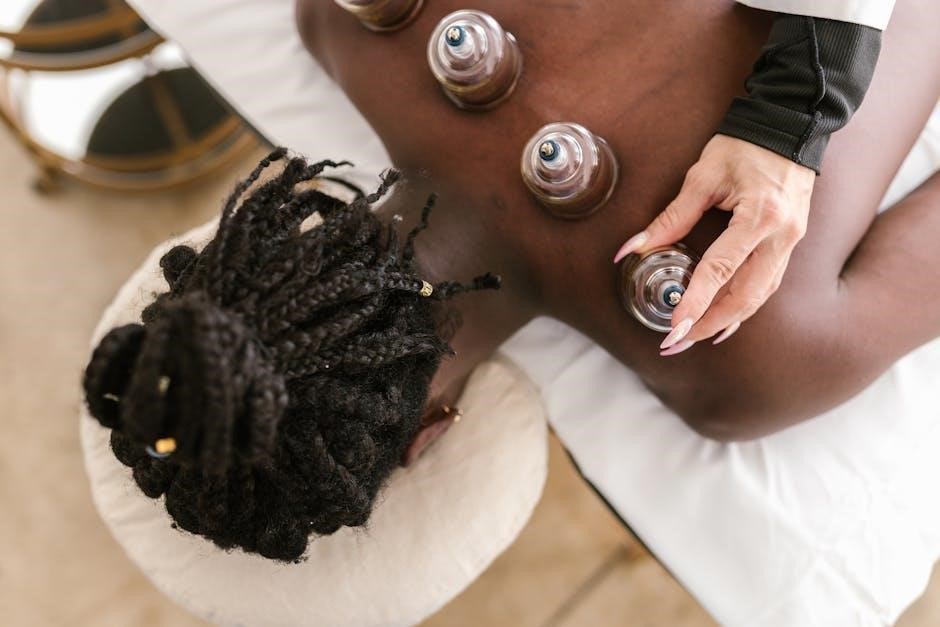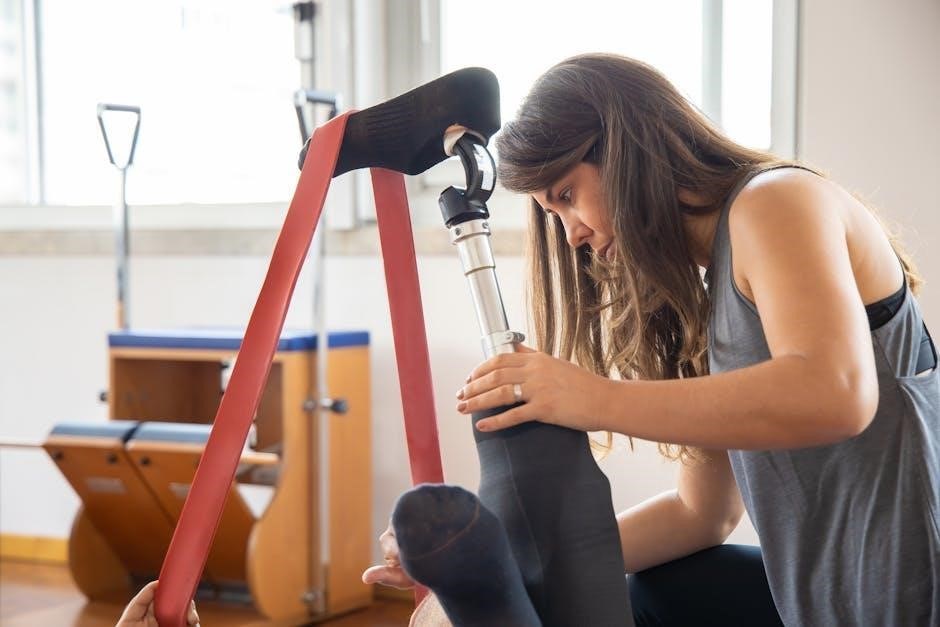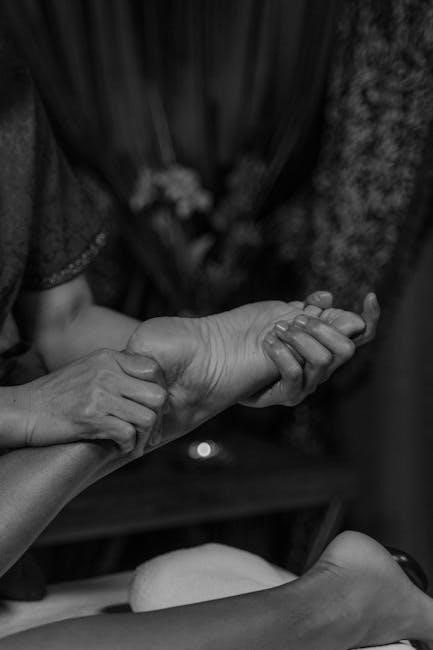crps physical therapy protocol pdf
Complex Regional Pain Syndrome (CRPS) is a chronic pain condition often occurring after trauma, with physical therapy playing a key role in managing symptoms and improving function.
1.1 Understanding CRPS (Complex Regional Pain Syndrome)
Complex Regional Pain Syndrome (CRPS) is a chronic pain condition, often occurring after trauma, characterized by intense burning pain, swelling, and sensitivity in affected limbs. Formerly known as Reflex Sympathetic Dystrophy (RSD), CRPS primarily affects arms or legs. Symptoms include hyperalgesia, allodynia, and vasomotor changes. The exact cause remains unclear, but it involves nervous system dysfunction. Early diagnosis is critical to prevent progression and complications. Prompt physical therapy is essential to manage symptoms, restore mobility, and improve quality of life. CRPS is more common in women, and its severity can vary widely. Physical therapy protocols often focus on pain reduction, functional improvement, and long-term management, making it a cornerstone of CRPS treatment.
1.2 The Role of Physical Therapy in CRPS Management
Physical therapy plays a vital role in managing CRPS by addressing pain, improving mobility, and restoring functional abilities. It often begins with gentle exercises to reduce stiffness and discomfort, progressing to strength and flexibility training. Techniques like graded motor exercises and mirror therapy are commonly used to desensitize affected areas and promote neural plasticity. Early intervention is crucial to prevent chronic disability and enhance quality of life. Physical therapy also focuses on educating patients in self-management strategies, such as proper posture and activity pacing, to minimize flare-ups. A tailored approach ensures individualized care, addressing the unique needs of each patient and fostering long-term recovery. Physical therapy is often combined with other treatments, like pain management, to optimize outcomes for CRPS patients.

Key Components of a CRPS Physical Therapy Protocol
A CRPS physical therapy protocol includes pain management, early intervention, and a biopsychosocial approach, focusing on exercises, modalities, and patient education to enhance mobility and reduce symptoms effectively.
2.1 Pain Management Strategies
Pain management in CRPS physical therapy is crucial and often multimodal. Early intervention with strategies like gentle exercises, desensitization, and strengthening is essential. Modalities such as heat, ice, or TENS may alleviate discomfort. Mirror therapy, starting with minimal movement, can help reduce pain perception. Prompt scheduling of physical therapy after sympathetic blocks (within 24 hours) enhances effectiveness. A biopsychosocial approach addresses both physical and emotional factors, improving adherence and outcomes. Patient-centered techniques ensure individualized care, focusing on reducing pain while restoring function and mobility. Regular reassessment of pain levels guides therapy progression, ensuring interventions remain tailored to the patient’s needs. Effective pain management is foundational for successful CRPS rehabilitation, enabling patients to engage fully in their treatment plan.
2.2 Early Intervention and Prompt Diagnosis
Early intervention and prompt diagnosis are critical in CRPS management, preventing progression and reducing long-term disability. Physical therapists play a vital role in identifying CRPS signs early, often post-trauma. Timely referral ensures symptoms are addressed before they intensify. Delayed diagnosis can lead to chronic pain and mobility issues, complicating treatment. Research emphasizes that initiating therapy soon after symptom onset improves outcomes. A prompt diagnosis allows for tailored treatment plans, minimizing complications and enhancing recovery. Early intervention also reduces the risk of secondary physical problems, such as disuse atrophy, ensuring better functionality and quality of life for patients. Thus, early detection and intervention are key to effective CRPS management and improved patient prognosis.
2.3 Biopsychosocial Approach to Treatment
The biopsychosocial approach is a comprehensive framework for CRPS treatment, addressing physical, psychological, and social factors. This model recognizes the interplay between biological symptoms, emotional well-being, and environmental influences. Physical therapy incorporates exercises to improve mobility and strength while psychological support helps manage pain perception and emotional distress. Social factors, such as family support and workplace accommodations, are also considered to enhance recovery. An interdisciplinary team, including physical therapists, psychologists, and occupational therapists, collaborates to create personalized plans. This holistic method ensures a well-rounded treatment strategy, improving function and quality of life for CRPS patients. By addressing all aspects of health, the biopsychosocial approach offers a balanced and effective treatment pathway.

Phases of CRPS Physical Therapy
CRPS physical therapy progresses through acute, subacute, and chronic phases, focusing on pain reduction, mobility improvement, and long-term management to restore function and quality of life.
3.1 Acute Phase: Reducing Pain and Inflammation
The acute phase of CRPS physical therapy focuses on managing pain and inflammation to prevent further tissue damage. Techniques such as gentle range-of-motion exercises, joint mobilization, and soft tissue massage are employed to maintain mobility without exacerbating symptoms. Modalities like ice therapy, electrical stimulation, and ultrasound may be used to reduce pain and swelling. Patient education on proper positioning and movement strategies is crucial to avoid aggravating the condition. Early intervention by physical therapists, in collaboration with other healthcare providers, ensures a comprehensive approach to symptom management during this critical phase.
3.2 Subacute Phase: Improving Mobility and Strength
The subacute phase of CRPS physical therapy emphasizes restoring mobility and strength while continuing to manage pain. Gentle exercises, such as progressive resistance training and weight-bearing activities, are introduced to enhance muscle function without exacerbating symptoms. Proprioceptive and balance exercises are incorporated to improve coordination and reduce the risk of further injury. This phase also focuses on addressing any compensatory movement patterns that may have developed due to pain. The goal is to gradually increase the patient’s functional abilities, preparing them for daily activities and reducing the likelihood of long-term disability. A tailored approach ensures that exercises are progression-based, aligning with the patient’s tolerance and recovery pace.
3.3 Chronic Phase: Long-Term Management and Prevention
In the chronic phase of CRPS physical therapy, the focus shifts to long-term management and prevention of symptom recurrence. Patients learn strategies to maintain functional abilities and manage pain independently. Home exercise programs are tailored to promote strength, flexibility, and mobility, with an emphasis on lifestyle adjustments to reduce flare-ups. Education on proper posture, ergonomics, and activity pacing is crucial. Psychological support is integrated to address chronic pain’s emotional impact, fostering resilience. Regular follow-ups with the physical therapist ensure continued progress and address any emerging challenges. The goal is to empower patients to take an active role in their care, minimizing reliance on passive treatments and enhancing overall quality of life. This phase emphasizes sustainability and self-efficacy, ensuring patients can thrive despite the chronic nature of CRPS.

Evidence-Based Practices in CRPS Physical Therapy
Evidence-based practices in CRPS physical therapy include mirror therapy, graded motor imagery, and exercise programs supported by research to enhance functional recovery and reduce chronic pain effectively.
4.1 Mirror Therapy for CRPS Management
Mirror therapy is a widely recognized intervention for CRPS, aiming to reduce pain and improve mobility by using visual feedback. It involves placing a mirror adjacent to the affected limb, creating the illusion of symmetrical movement. Patients perform exercises with the unaffected limb while observing the reflection, which tricks the brain into perceiving movement in the affected limb. This technique helps recalibrate neural pathways, diminishing pain and stiffness. Studies suggest that mirror therapy, when integrated into a physical therapy protocol, can significantly improve functional outcomes. It is often initiated in the acute phase, starting with passive movements and progressing to active exercises as tolerance allows. Evidence supports its efficacy in reducing chronic pain and enhancing motor function.
4.2 Exercise Therapy: Types and Progression
Exercise therapy is a cornerstone of CRPS management, tailored to the patient’s stage and symptoms. It begins with gentle range-of-motion exercises to maintain joint mobility and progresses to strengthening exercises to improve muscular function. Proprioceptive and balance exercises are also incorporated to enhance sensory integration and reduce pain. The progression is guided by pain levels and functional goals, ensuring exercises are challenging yet tolerable. Early stages focus on pain-free movements, while advanced phases aim to restore full mobility and strength. Studies highlight the importance of individualizing exercise plans and integrating them with other modalities for optimal outcomes. Regular reassessment ensures the protocol evolves with the patient’s recovery, promoting long-term functional improvement and reducing the risk of relapse.
4.3 Use of Modalities in Pain Relief
Modalities such as ice, heat, or electrical stimulation are often used in CRPS physical therapy to alleviate pain and inflammation. Techniques like transcutaneous electrical nerve stimulation (TENS) and ultrasound can help reduce discomfort and improve tissue healing. Desensitization exercises, including gentle tactile stimulation, are also employed to decrease hypersensitivity. Additionally, mirror therapy has shown promise in reducing pain by altering the brain’s perception of the affected limb. These modalities are typically applied in conjunction with exercise programs to enhance their effectiveness. The choice of modality depends on the patient’s stage of CRPS and their specific symptoms. Evidence supports the use of these methods as part of a multimodal approach to pain management, emphasizing the importance of tailoring treatments to individual needs for optimal relief;

Patient-Centered Care in CRPS Rehabilitation
Patient-centered care in CRPS focuses on education, empowerment, and personalized treatment plans, ensuring patients are active participants in their recovery journey and overall well-being.
5.1 Patient Education and Empowerment
Patient education is a cornerstone of CRPS rehabilitation, enabling individuals to understand their condition, symptoms, and treatment options. Empowering patients fosters active participation in their care, improving adherence to therapy regimens and overall outcomes. Physical therapists play a vital role in providing personalized resources and tools, helping patients manage pain, perform exercises, and adopt lifestyle modifications. Education also addresses psychological aspects, reducing anxiety and promoting coping strategies. By equipping patients with knowledge, they gain control over their recovery, enhancing their quality of life and ability to self-advocate. This approach ensures patients are informed partners in their rehabilitation journey, aligning with a patient-centered care model.
5.2 Individualized Treatment Plans
Individualized treatment plans are essential for managing CRPS effectively, as they cater to each patient’s unique needs and symptoms. Physical therapists work closely with patients to assess their condition, set realistic goals, and tailor interventions. These plans incorporate evidence-based modalities, exercises, and modalities, ensuring a personalized approach. Regular assessments allow adjustments to be made, optimizing progress and addressing any emerging challenges. Collaboration with other healthcare professionals further enhances the plan’s effectiveness, ensuring comprehensive care. By focusing on specific impairments and functional limitations, individualized plans aim to maximize recovery, improve mobility, and reduce pain, thereby enhancing the patient’s overall quality of life.
5.3 Monitoring Progress and Adjusting Protocols
Monitoring progress is critical in CRPS physical therapy to ensure treatment efficacy and adapt to the patient’s evolving needs. Regular assessments are conducted using outcome measures such as pain levels, functional abilities, and patient-reported improvements. Physical therapists continuously communicate with patients to identify changes in symptoms or challenges. Adjustments to protocols are based on these assessments, ensuring interventions remain effective and aligned with recovery goals. Evidence-based practices guide modifications, such as introducing new exercises or modalities. This dynamic approach ensures personalized care, addressing the chronic and unpredictable nature of CRPS. By maintaining flexibility, physical therapy protocols can evolve to support long-term management and optimize patient outcomes, fostering resilience and adaptation. This iterative process is vital for achieving sustained improvements in function and quality of life.

Interdisciplinary Approach to CRPS Treatment
A multidisciplinary team, including physical therapists, physicians, occupational therapists, and psychologists, collaborates to optimize CRPS outcomes through comprehensive, coordinated care tailored to the patient’s needs.
6.1 Collaboration Between Physical Therapists and Physicians
Effective CRPS management requires close collaboration between physical therapists and physicians to ensure comprehensive care. Physicians often diagnose CRPS and initiate medical interventions, while physical therapists design rehabilitation programs to improve mobility and strength. This teamwork ensures a unified approach, addressing both pain and functional limitations.
Regular communication between physical therapists and physicians allows for real-time adjustments to treatment plans, ensuring optimal progress; This collaborative model promotes better patient outcomes, enhances quality of life, and supports long-term recovery, making it a cornerstone of CRPS care.
6.2 Role of Occupational Therapy in CRPS Management
Occupational therapy plays a vital role in CRPS management by focusing on improving daily functioning and reducing disability. Occupational therapists help patients adapt to physical limitations, enabling them to perform essential activities despite pain or mobility challenges.
Strategies include the use of adaptive equipment, ergonomic adjustments, and pain management techniques. Occupational therapy also addresses psychological factors, such as anxiety or depression, which often accompany chronic pain. By fostering independence and promoting participation in meaningful tasks, occupational therapy complements physical therapy, ensuring a holistic approach to CRPS care and enhancing overall quality of life for patients.
6.3 Psychological Support for CRPS Patients
Psychological support is a critical component of CRPS management, as chronic pain often leads to mental health challenges like depression, anxiety, and stress. Cognitive-behavioral therapy (CBT) and mindfulness-based stress reduction (MBSR) are commonly used to help patients cope with pain and improve emotional well-being.
These interventions focus on reshaping negative thought patterns, enhancing coping strategies, and promoting relaxation techniques. Additionally, psychological support fosters a sense of control and empowerment, which is essential for managing the unpredictable nature of CRPS. By addressing both the mental and physical aspects of the condition, psychological support complements physical therapy and enhances overall treatment outcomes, improving patients’ quality of life and resilience. Early integration of psychological care is vital for optimal recovery and long-term well-being.

Outcomes and Efficacy of CRPS Physical Therapy
Physical therapy significantly improves pain management, functional ability, and quality of life for CRPS patients. Studies and patient feedback consistently support its effectiveness in achieving long-term recovery goals.
7.1 Case Studies Highlighting Successful PT Outcomes
Case studies demonstrate the effectiveness of physical therapy in managing CRPS, with significant reductions in pain and improvement in functional abilities; A 61-year-old female with post-surgical CRPS experienced reduced foot pain and enhanced mobility through targeted exercises and mirror therapy. Another study highlighted a patient achieving long-term pain relief and restored activity levels after a structured PT program. These examples underscore the importance of early intervention and personalized treatment plans. Successful outcomes often involve interdisciplinary approaches, combining physical therapy with psychological support and patient education. Such case studies provide valuable insights into the efficacy of PT protocols, offering hope and evidence-based strategies for CRPS patients seeking improved quality of life and lasting recovery.
7.2 Clinical Trials Supporting PT Protocols
Clinical trials have consistently demonstrated the efficacy of physical therapy in managing CRPS, with protocols showing significant improvements in pain reduction and functional recovery. Studies highlight the benefits of interventions like mirror therapy and graded motor imagery, which have been proven to reduce symptoms and enhance mobility. Exercise programs tailored to CRPS stages have also shown positive outcomes, with patients experiencing decreased pain intensity and improved quality of life. These trials underscore the importance of early and sustained physical therapy intervention. While larger, more detailed studies are needed, existing evidence strongly supports the inclusion of PT in CRPS management. Such findings have guided the development of standardized protocols, ensuring patients receive evidence-based care for optimal recovery and long-term well-being.
7.3 Patient Satisfaction and Quality of Life Improvements
Physical therapy protocols for CRPS have been associated with significant improvements in patient satisfaction and quality of life. Patients often report reduced pain intensity, enhanced mobility, and better functional abilities, leading to increased independence in daily activities. These improvements contribute to higher overall well-being and emotional resilience. Many patients express satisfaction with personalized treatment plans that address their unique needs and goals. The integration of education and empowerment strategies further enhances patient engagement and self-management capabilities. While individual responses to therapy vary, the consistent positive outcomes underscore the value of physical therapy in improving both physical and emotional quality of life for CRPS patients, fostering long-term well-being and confidence in managing their condition.

Resources and Tools for CRPS Physical Therapy
Accessing CRPS physical therapy protocol PDFs and guidelines provides structured approaches for managing symptoms and improving function, supported by evidence-based practices and interdisciplinary care strategies.
8.1 Accessing CRPS Physical Therapy Protocol PDFs
CRPS physical therapy protocol PDFs provide comprehensive, evidence-based guidelines for managing symptoms and improving function. These resources outline structured approaches, including exercise therapy, modalities, and interdisciplinary care. They are designed to help physical therapists develop personalized treatment plans, ensuring effective pain management and functional improvement. Many PDFs include detailed exercise progressions, modalities such as mirror therapy, and strategies for addressing biopsychosocial factors. Accessing these protocols ensures clinicians stay updated on best practices, enabling them to deliver optimal care. By following these guidelines, therapists can help patients achieve better outcomes, reducing pain and enhancing quality of life. These PDFs are invaluable tools for both professionals and patients seeking structured approaches to CRPS management.
8.2 Recommended Exercise and Therapy Guidelines
Recommended exercise and therapy guidelines for CRPS emphasize a structured, evidence-based approach to managing symptoms and improving function. These guidelines typically include graded exercises tailored to the patient’s pain level and functional abilities. Early intervention focuses on pain management and mobility, progressing to strength and functional exercises in later stages. Modalities like mirror therapy and desensitization techniques are often recommended to address neuropathic pain and improve limb function. Exercise protocols are designed to avoid exacerbating pain, with gradual progression to prevent overloading. These guidelines also highlight the importance of combining physical therapy with psychological support to address the biopsychosocial aspects of CRPS. By following these structured approaches, patients can achieve significant improvements in pain reduction and mobility, enhancing their overall quality of life.
8.3 Online Communities and Support Groups
Online communities and support groups play a vital role in helping CRPS patients cope with their condition. These platforms provide emotional support, share experiences, and offer practical advice on managing pain and rehabilitation. Many forums and social media groups, such as Facebook groups dedicated to CRPS, allow patients to connect with others facing similar challenges. These communities often share resources, including recommended exercises and therapy guidelines, as well as personal tips for navigating daily life with CRPS. Additionally, online support groups can help reduce feelings of isolation and provide motivation for adhering to physical therapy protocols. They also serve as a space to discuss the latest research and treatments, fostering a sense of community and empowerment among members.
Physical therapy is crucial in managing CRPS, emphasizing early intervention and personalized care to enhance outcomes. Further research is essential for advancing treatment protocols effectively.
9.1 The Importance of Early and Appropriate Physical Therapy
Early intervention is critical in managing CRPS, as delays can lead to chronic pain and reduced functionality. Prompt diagnosis and tailored physical therapy protocols help mitigate symptoms, improving mobility and quality of life. A multidisciplinary approach ensures comprehensive care, addressing both physical and psychological aspects. Studies highlight that initiating therapy soon after diagnosis significantly enhances outcomes, reducing long-term disability. Emphasizing patient-centered strategies fosters empowerment and adherence, making early and appropriate physical therapy indispensable in CRPS management.
9.2 Future Directions in CRPS Research and Treatment
Future research in CRPS should focus on understanding its pathophysiology to develop targeted therapies. Advances in neuroplasticity and pain mechanisms could lead to more effective treatments. Clinical trials exploring exercise protocols and modalities are essential. Personalized medicine and biomarker identification may revolutionize diagnosis and treatment. Collaborative efforts between disciplines can enhance care. Emerging technologies like virtual reality and teletherapy offer innovative solutions. Addressing disparities in access to care is crucial. By prioritizing patient-centered approaches, future research can improve outcomes and quality of life for CRPS patients, ensuring comprehensive and sustainable management strategies.